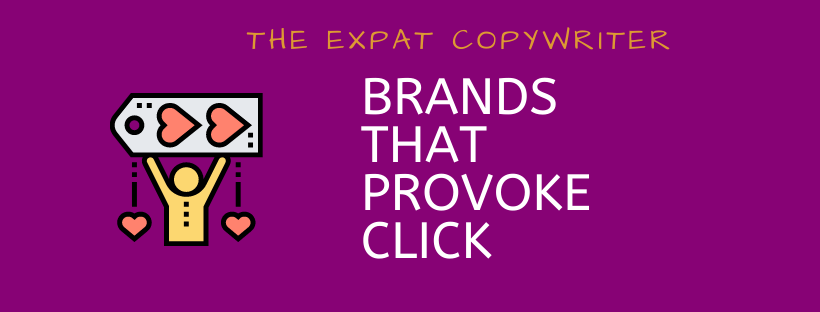Billions of brands out there and you want yours to stand out.
But how to do it?
How do you make your voice heard in the hustle and bustle of the Internet and make customers choose you?
Think about it.
Who are the people who have most impacted you?
Those who you spoke to only once and still remember them?
Surely you remember them not because of what they said, but because of how they made you feel.
Maybe you also remember them because of their looks, which attracted you straight away.
A brand should be the same.
Not only the appearance matters, the personality is what will make people pay attention.
If you want your business to stand out, you need to create a brand that has personality, to ensure it will be seen above the others.
But let’s first have a look at what a brand exactly is, the concept can sometimes be a bit diffuse.
The concept of brand
The traditional definition of a brand in the Oxford dictionary reads:
“A type of product, service, etc. made or offered by a particular company under a particular name”.
But you and I know that a brand goes much beyond that.
In the book Read Me, 10 Lessons for Writing Great Copy, by Horberry and Lingwood they define brand in this way:
“Brand is a mixture of attributes, tangible and intangible, symbolised by a registered trademark, which if properly managed, can create value and influence the public.”
A brand can be a product but it can also be a place.
For example, advertising campaigns that are made about a place to encourage tourism also try to create a brand, as Spain has done this year with the campaign “Spain will wait”.
That promise, if it truly delivers on what it promises, will become an experience and help sell even more with the positive reviews that customers will leave behind.
“Red Bull Gives You Wings“
“L’Oreal – Because you’re Worth it”
“M&Ms, Melts in your Mouth, not in your Hands”
Jeff Bezos, founder of Amazon and the richest man on earth, defines brand this way:
“A company’s brand is like a person’s reputation. You earn your reputation by trying to do things right.”
Therefore the company is not the true owner of the brand, in the end it’s the public who owns that brand and makes it their own.
Copywriting to create a brand personality
One of the most difficult but most rewarding tasks for a copywriter is to help create a brand.
It’s something that involves a lot of work as you are faced with a blank canvas since you start from 0.
But that’s why it’s so exciting, because you have all the freedom to give it the angle you think will work best.
When you write for an established brand you have to follow some guidelines, unless you’ve been hired to totally change the dialogue and resurrect a brand that’s fading.
So what’s the first thing to do?
As in any copywriting process, the first thing is to do research on the buyer persona and the market to observe what other brands are doing and what our audience really wants.
After this research, we will see clearer what differentiates us and makes us unique, and we will be able to choose a Big Idea on which to base our whole strategy.
Recommended reading How to research your buyer persona
The key piece of your brand: The Big Idea.
How do you identify that an idea is the Big Idea?
It’s the main idea on which we are going to base our brand personality.
All the brands that stand out are based on a single Big Idea.
Apple – “Think Different”
Nike- “Just Do It”.
To identify that an idea is a Big Idea it must have the following characteristics:
Unusual: Do you feel that you have already seen that idea somewhere else? Then forget about it.
Specific: Can you explain it in a simple way?
Credible: Is your idea perfectly probable?
Emotion: Does your idea evoke sadness, joy, curiosity?
A story: Can you develop your idea around a story?
If your idea meets all these characteristics, it will be more likely to resonate with people and that’s exactly what you need: to reach your audience’s core.
Connecting with your audience
We have often heard that people buy from a person, not the thing itself.
This reminds me of a former colleague at the company where I worked for 8 years, let’s call it X, who always said “MediaMarkt doesn’t buy from X, they buy from Raúl P”
And he was quite right.
He was a great salesman and was largely responsible for our product selling so well at MediaMarkt.
Obviously the product was good, otherwise, however skilled a commercial can be, he won’t be able to sell a third time.
It’s clear that in the buying process human relations count for a lot, and this hasn’t changed in the era of ecommerce.
People buy brands with which they feel an emotional connection.
The emotional beats the rational because it makes people feel identified with the product.
I’m not saying you should discard the rational side of things completely. Explaining in a logical way the reasons why people should buy your product will always help. For example, adding data and explaining in more detail the technical features.
But it’s important to look for that emotional connection which in the end is more powerful.
Copywriting plays an essential role here.
When writing for your brand (web copy, emails, articles, social media posts) the language you choose should make the reader feel part of a club; part of those people who think differently (Apple) or of those others who dare (Nike).
The type of language used should make the brand attractive in the eyes of the target customer, since it shares the same values and because it also uses expressions that attract their attention.
A good copywriter knows what kind of language will attract the attention of the right audience and how to make that brand stand out from the rest.
And how do we do it?
Let me give you a concrete example.
I just finished a copy project for a fashion photographer.
To be honest, I’m not into fashion, I like clothes, yes, but I don’t follow influencers or read fashion magazines.
The first thing I did before writing anything was read as many fashion magazines as I could and got into Instagram for the first time in months.
What I wanted was to get that voice that magazines and some influencers use.
I dived in their expressions and tone of voice and wrote like they would.
Like they would do, but with a clear strategy behind it: to catapult the brand I was working for.
I use a formula that always works for me and that I have perfected over the years.
My copywriting formula:
Use the expressions and mannerisms of the ideal customer to express their concerns and desires in order to introduce THE promise (Great Idea).
This is how you get the attention of your target audience.
Basic components that every brand must have
Let’s now quickly look at the basic components you need to consider when creating your brand.
- The Big Idea or essence: the central concept that captures the main difference of your brand. Invest as much time as necessary until you find it because it’s vital for your business to stand out.
- Language: This is the part we have concentrated on in this post. It’s the voice of your brand and it‘s present in everything you do. In the name, the slogan, on the web, social media, catalogues, EVERYTHING. Therefore it has to be consistent.
- Design: put care into designing your logo, website, etc. Investing in a good designer as soon as possible will provide better results.
- Name: deciding on a name for your brand can provoke many headaches, but it’s important to choose well. The name can be descriptive (7-Eleven), evocative (Patagonia), superlative (Mr Proper) or abstract (Bershka). Choose it with your Big Idea and your audience in mind.
- Representative: There are brands that have a person as a powerful image, think of Steve Jobs or Zuckerberg. You can be the image of your brand, or if you prefer it, you can hire someone.
Your brand will help your business to take off and to make it on the Internet.
Don’t skimp on it, because how different and suggestive your brand is will largely determine the success of your company.
See you around!





0 Comments